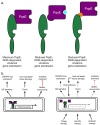Resistance Is Not Futile: The Role of Quorum Sensing Plasticity in Pseudomonas aeruginosa Infections and Its Link to Intrinsic Mechanisms of Antibiotic Resistance
- PMID: 35744765
- PMCID: PMC9228389
- DOI: 10.3390/microorganisms10061247
Resistance Is Not Futile: The Role of Quorum Sensing Plasticity in Pseudomonas aeruginosa Infections and Its Link to Intrinsic Mechanisms of Antibiotic Resistance
Abstract
Bacteria use a cell-cell communication process called quorum sensing (QS) to orchestrate collective behaviors. QS relies on the group-wide detection of extracellular signal molecules called autoinducers (AI). Quorum sensing is required for virulence and biofilm formation in the human pathogen Pseudomonas aeruginosa. In P. aeruginosa, LasR and RhlR are homologous LuxR-type soluble transcription factor receptors that bind their cognate AIs and activate the expression of genes encoding functions required for virulence and biofilm formation. While some bacterial signal transduction pathways follow a linear circuit, as phosphoryl groups are passed from one carrier protein to another ultimately resulting in up- or down-regulation of target genes, the QS system in P. aeruginosa is a dense network of receptors and regulators with interconnecting regulatory systems and outputs. Once activated, it is not understood how LasR and RhlR establish their signaling hierarchy, nor is it clear how these pathway connections are regulated, resulting in chronic infection. Here, we reviewed the mechanisms of QS progression as it relates to bacterial pathogenesis and antimicrobial resistance and tolerance.
Keywords: antibiotic resistance; quorum sensing; virulence.
Conflict of interest statement
The authors declare that they have no conflict of interest with the contents of this article. The content is solely the responsibility of the authors and does not necessarily represent the official views of the National Institute of Health. The funders had no role in study design, data collection, and analysis, decision to publish, or preparation of the manuscript.
Figures



Similar articles
-
The PqsE-RhlR Interaction Regulates RhlR DNA Binding to Control Virulence Factor Production in Pseudomonas aeruginosa.Microbiol Spectr. 2022 Feb 23;10(1):e0210821. doi: 10.1128/spectrum.02108-21. Epub 2022 Jan 12. Microbiol Spectr. 2022. PMID: 35019777 Free PMC article.
-
LasR Variant Cystic Fibrosis Isolates Reveal an Adaptable Quorum-Sensing Hierarchy in Pseudomonas aeruginosa.mBio. 2016 Oct 4;7(5):e01513-16. doi: 10.1128/mBio.01513-16. mBio. 2016. PMID: 27703072 Free PMC article.
-
PqsE Is Essential for RhlR-Dependent Quorum Sensing Regulation in Pseudomonas aeruginosa.mSystems. 2020 May 26;5(3):e00194-20. doi: 10.1128/mSystems.00194-20. mSystems. 2020. PMID: 32457239 Free PMC article.
-
An evolving perspective on the Pseudomonas aeruginosa orphan quorum sensing regulator QscR.Front Cell Infect Microbiol. 2014 Oct 28;4:152. doi: 10.3389/fcimb.2014.00152. eCollection 2014. Front Cell Infect Microbiol. 2014. PMID: 25389523 Free PMC article. Review.
-
Sesamin and sesamolin rescues Caenorhabditis elegans from Pseudomonas aeruginosa infection through the attenuation of quorum sensing regulated virulence factors.Microb Pathog. 2021 Jun;155:104912. doi: 10.1016/j.micpath.2021.104912. Epub 2021 Apr 28. Microb Pathog. 2021. PMID: 33932548 Review.
Cited by
-
A Geneticist Transcribing the Chemical Language of Bacteria.Isr J Chem. 2023 Jun;63(5-6):e202200079. doi: 10.1002/ijch.202200079. Epub 2022 Dec 1. Isr J Chem. 2023. PMID: 37469628 Free PMC article.
-
Inflammation-like environments limit the loss of quorum sensing in Pseudomonas aeruginosa.mSystems. 2025 Aug 19;10(8):e0172224. doi: 10.1128/msystems.01722-24. Epub 2025 Jul 7. mSystems. 2025. PMID: 40621905 Free PMC article.
-
Resistance, Tolerance, Virulence and Bacterial Pathogen Fitness-Current State and Envisioned Solutions for the Near Future.Pathogens. 2023 May 22;12(5):746. doi: 10.3390/pathogens12050746. Pathogens. 2023. PMID: 37242416 Free PMC article. Review.
-
In Vitro and In Silico Screening of Anti-Vibrio spp., Antibiofilm, Antioxidant and Anti-Quorum Sensing Activities of Cuminum cyminum L. Volatile Oil.Plants (Basel). 2022 Aug 29;11(17):2236. doi: 10.3390/plants11172236. Plants (Basel). 2022. PMID: 36079620 Free PMC article.
-
Inhibitors of the PqsR Quorum-Sensing Receptor Reveal Differential Roles for PqsE and RhlI in Control of Phenazine Production.ACS Chem Biol. 2025 Jun 20;20(6):1273-1287. doi: 10.1021/acschembio.5c00114. Epub 2025 May 14. ACS Chem Biol. 2025. PMID: 40366200 Free PMC article.
References
-
- Redfield R.R. Antibiotic Resistance Threats in the United States. Centres for Disease Control and Prevention; Atlanta, GA, USA: 2019.
-
- Centers for Disease Control and Prevention . Biggest Threats and Data: 2019 AR Threats Report. CDC; Atlanta, GA, USA: 2019.
-
- Bjarnsholt T., Jensen P.O., Jakobsen T.H., Phipps R., Nielsen A.K., Rybtke M.T., Tolker-Nielsen T., Givskov M., Hoiby N., Ciofu O., et al. Quorum sensing and virulence of Pseudomonas aeruginosa during lung infection of cystic fibrosis patients. PLoS ONE. 2010;5:e10115. doi: 10.1371/journal.pone.0010115. - DOI - PMC - PubMed
-
- Wolter D.J., Lister P.D. Mechanisms of beta-lactam resistance among Pseudomonas aeruginosa. [(accessed on 25 November 2021)];Curr. Pharm. Des. 2013 19:209–222. doi: 10.2174/138161213804070311. Available online: https://www.ncbi.nlm.nih.gov/pubmed/22894618. - DOI - PubMed
Publication types
Grants and funding
LinkOut - more resources
Full Text Sources

